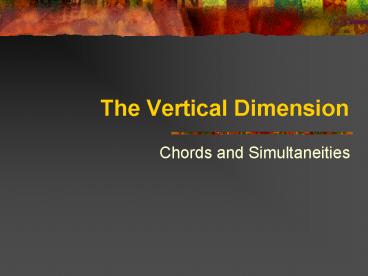The Vertical Dimension - PowerPoint PPT Presentation
1 / 8
Title:
The Vertical Dimension
Description:
Quartal and Quintal chords can have as few as three pitches to many more. ... arranged in various manners -- as quintal, quartal, or tertian chords -- the ... – PowerPoint PPT presentation
Number of Views:542
Avg rating:3.0/5.0
Title: The Vertical Dimension
1
The Vertical Dimension
- Chords and Simultaneities
2
Harmony
- With the exception of a few voice-leading chords,
harmony from the Common Practice period consists
of thirds. - This was a result of the classifications of
consonance and dissonance and the development of
voice-leading procedures over the centuries. - The music of the twentieth century also uses
tertian harmonies, but there is a lot of music
using chords built with 2nds, 4ths, 5ths, etc. - Some chords are the result of somewhat accidental
combinations of independent lines.
3
Conventional Tertian Sonorities
- Some composers make more use of triads and
seventh chords than others. - 9th, 11th, and 13th chords are beginning to be
used by the end of the nineteenth and start of
the twentieth centuries. - These extensions are most commonly applied to
dominant and secondary dominant chords, and
sometimes to the supertonic and submediant
chords. - Chromatic alteration, especially to dominant
functioning chords is common. - Often the sonorities are incomplete.
- These chords can be inverted, however these
inversions can be ambiguous.
4
Chords of Addition
- Chords with added notes became accepted in the
twentieth century. - 2nds, 6ths, and sometimes 4ths.
- The musical context is what decides the analysis
of the chord -- an added sixth could be an
inverted seventh chord. - 2nds and 4ths are considered the same as 9ths and
11ths -- it all depends on where the added note
is in relation to the root.
5
Split Chord Members
- Split chord members are a special kind of added
note. - They have an added note that is a minor second
away from another chord member. - Commonly a triad or seventh chord with a split
third. - Split roots, fifths, and sevenths do occur.
6
Chord of Omission
- The open-fifth chord is the only important chord
of omission. - Leaving out any other chord member only results
in another traditional harmony. - The sound of this sonority quickly becomes
tiresome, therefore extended passages using the
open-fifth chord are rare.
7
Quartal and Quintal Chords
- Quartal and Quintal chords can have as few as
three pitches to many more. - The voicings, octave duplications, and
orchestration determine the chord. - 3 x 4 on E means a quartal chord with 3 members
built on E. 7 x 5 on D means a quintal chord
with 7 members built on D. - The use of augmented fifths and diminished
fourths can be confusing because they sound like
thirds and sixths.
8
Other Chords
- Secundal chords can be voiced as sevenths, but
the notes are most commonly voiced adjacent to
each other. - Often referred to as a tone cluster.
- Mixed-interval chords combine two or more
interval types. - Since they can often be arranged in various
manners -- as quintal, quartal, or tertian chords
-- the chord should be analyzed within the
context of the music. - Polychords are formed by combining two or more
chords into a sonority. - They must be heard as two chords played
simultaneously -- separated by register or timbre
-- or they are probably 11th or 13th chords.































